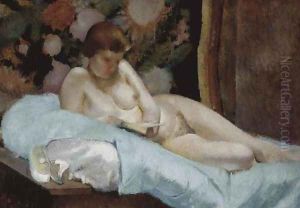Stanislaw Szczepanski Paintings
Stanisław Szczepański was a Polish painter and representative of the interwar period, whose work is less widely known compared to other artists of his time. Born on November 1, 1897, in Warsaw, Poland, he was a part of the Polish avant-garde movement, which was a bustling and innovative art scene during the early 20th century. During his lifetime, Poland underwent significant changes, including regaining its independence in 1918 after 123 years of partitions by Russia, Prussia, and Austria.
Szczepański's artistic career was influenced by the turbulent political and social conditions of his homeland. He studied at the Warsaw School of Fine Arts, which was a hub for avant-garde ideas and experimentation. His work was influenced by various art movements of the time, including Expressionism, Constructivism, and Cubism. He was particularly interested in the constructivist approach to art, which involved a focus on abstraction and the use of industrial materials, but there is little detailed information available about his contributions to the movement or his individual style.
The outbreak of World War II and the subsequent occupation of Poland by Nazi Germany had a profound impact on Szczepański’s life and career. Many Polish artists faced persecution, and their work was often censored or destroyed. It is during this period that Szczepański's life came to a tragic end. He was involved in the Polish resistance movement, and for his activities, he was arrested by the Gestapo. He was executed on August 4, 1944, during the Warsaw Uprising, which was a major operation by the Polish resistance Home Army to liberate Warsaw from German occupation.
Due to the destruction brought by the war and the suppression of Polish culture during the subsequent Soviet domination, many works of artists like Szczepański were lost or remain little known. Consequently, detailed records of Szczepański's oeuvre are scarce, and his contributions to the art world are not as documented as those of his contemporaries. The fragments of his life that are known showcase him as a figure of resilience and creativity in a time of oppression and war.
